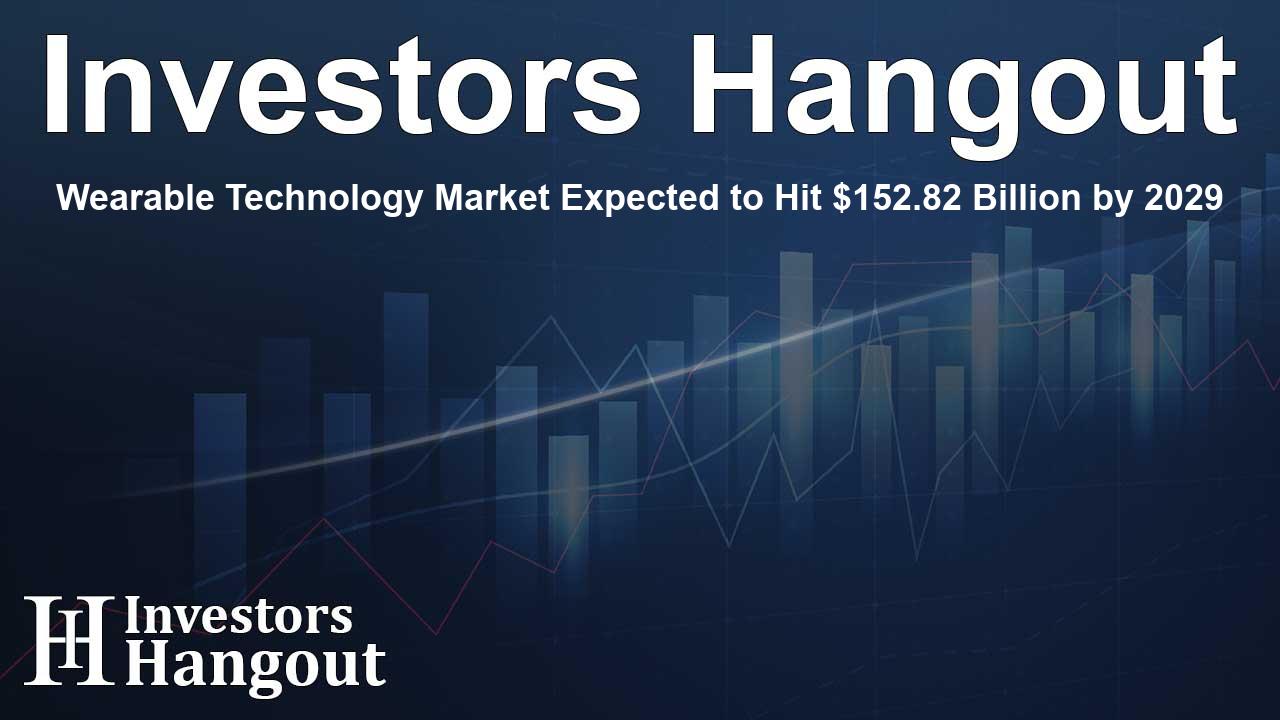Wearable Technology Market Expected to Hit $152.82 Billion by 2029

Wearable Technology Market Forecast for Expansion
The global wearable technology market is on track for significant growth, with projections indicating a valuation of USD 152.82 billion by 2029. This remarkable increase comes from an initial value of USD 70.30 billion expected in 2024, reflecting a robust compound annual growth rate (CAGR) of 16.8% through this period.
Factors Fueling Market Growth
The demand for wearables that consolidate multiple computing functions into a single compact device is a primary driver of market expansion. Many consumers are seeking wearable devices that provide seamless integration of fitness tracking, multimedia, and other functionalities. In particular, enhancements in sports performance optimization through real-time metrics monitoring is also pushing strong adoption rates in this technology.
Rapid Advancements in Technology
One major component contributing to the market's rise is the ongoing advancements in projector and sensor technology, enabling the production of cost-effective and sophisticated devices. Cheaper sensor technologies and advanced microchip design have allowed for the miniaturization of devices, making wearables more accessible. Furthermore, the integration of augmented reality (AR) and virtual reality (VR) capabilities within these devices presents intriguing opportunities for future expansions in various sectors.
Key Players in Wearable Technology
Leading companies in the wearable technology industry include significant names like Apple Inc., Garmin Ltd., Samsung, Sony Group Corporation, and Huawei Technologies Co., Ltd. These companies are at the forefront of innovation, consistently delivering products that set the market standard.
Understanding Market Segmentation
The market segmentation reveals that consumer electronics applications will continue to dominate share in the upcoming years. The proliferation of low-cost wearable devices has made fitness tracking more appealing, prompting users to engage in healthier lifestyles. Various accessories, such as smartwatches, fitness trackers, and smart clothing, have effectively captured consumer interest.
Trends in AI-Based Wearable Technology
AI-based wearable technology is set to expand the market even further, as it offers personalized user experiences. With the integration of artificial intelligence, these devices will gain capabilities that allow for enhanced health insights and predictive analytics. AI can also function to prolong device efficiency, improve user interaction through natural language processing, and automate health anomaly detection.
The Impact of the Asia Pacific Market
The Asia Pacific region is particularly noteworthy, expected to experience the highest CAGR in the market. Factors such as increased smartphone penetration, growing health awareness among the aging population, and the proliferation of internet access facilitate a rise in demand for health-monitoring wearables. Moreover, the focus on developing smart cities and digital health initiatives creates a supportive atmosphere for wearable technology to flourish.
Opportunities and Market Challenges
The wearable technology market presents lucrative opportunities stemming from the evolution of next-generation displays and ongoing product innovation. Key players are anticipated to capitalize on these prospects with new launches, targeting AI-powered segments expected to exhibit significant growth.
AI's Role in Technology Efficiency
By leveraging AI technologies, including deep learning and machine learning, wearable devices are achieving improved accuracy and efficiency. Increased performance from advanced algorithms is essential to tackling challenges within the wearable tech landscape. However, challenges persist, such as cybersecurity concerns highlighted in recent reports, emphasizing the need for robust solutions to protect user data.
Frequently Asked Questions
What is the expected market value of wearable technology by 2029?
The wearable technology market is anticipated to reach USD 152.82 billion by 2029.
What factors are driving the growth of wearable technology?
Key drivers include demand for integrated devices, real-time performance tracking, and advancements in sensor technologies.
Who are the major players in the wearable technology sector?
Notable companies include Apple Inc., Garmin Ltd., Samsung, and Huawei Technologies Co., Ltd., among others.
Which region is expected to grow the fastest in the wearable technology market?
The Asia Pacific region is projected to maintain the highest growth rate in the wearable tech market.
How is artificial intelligence impacting wearable technology?
AI enhances user experience by providing advanced health insights and automating device functions, contributing to market growth.
About The Author
Contact Dominic Sanders privately here. Or send an email with ATTN: Dominic Sanders as the subject to contact@investorshangout.com.
About Investors Hangout
Investors Hangout is a leading online stock forum for financial discussion and learning, offering a wide range of free tools and resources. It draws in traders of all levels, who exchange market knowledge, investigate trading tactics, and keep an eye on industry developments in real time. Featuring financial articles, stock message boards, quotes, charts, company profiles, and live news updates. Through cooperative learning and a wealth of informational resources, it helps users from novices creating their first portfolios to experts honing their techniques. Join Investors Hangout today: https://investorshangout.com/
The content of this article is based on factual, publicly available information and does not represent legal, financial, or investment advice. Investors Hangout does not offer financial advice, and the author is not a licensed financial advisor. Consult a qualified advisor before making any financial or investment decisions based on this article. This article should not be considered advice to purchase, sell, or hold any securities or other investments. If any of the material provided here is inaccurate, please contact us for corrections.
